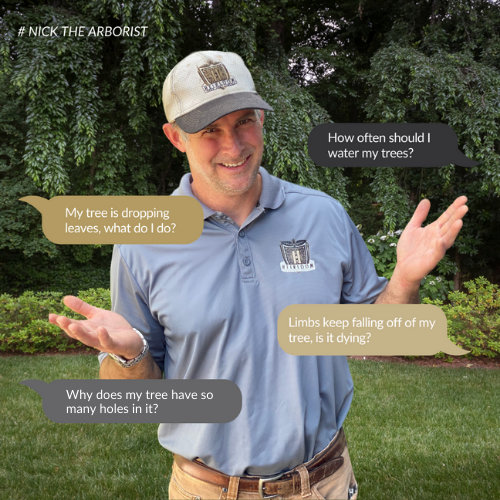Q and A with a Certified Arborist

Answering All Your Questions
Q. How often should I water during the summer and for how long?
A. How much to water can be a difficult question. There are many factors such as soil types (sand, clay, or silt). Temperatures and conditions such as full sun or shade. On average, in the summer I would say trees could be watered once a week until the ground is saturated, but make sure the soil has some amount of time to dry out before watering again, so the trees do not drown.
Q. Why does my tree have dead limbs?
A. There can be a lot of reasons for dead limbs. It can be natural causes such as shading where a limb is out competed and becomes shaded to death. It’s the trees way of expelling what it no longer needs. Now, if you see excessive dead tips or dead leaves, this could be an indicator of stress. Either way, it’s best to have it looked at by an arborist.
Q. Why are my leaves dropping in summer?
A. The more foliage a tree has, the more water a tree requires. So in the middle of the summer, especially in a drought, a tree starts to drop its leaves as a way to conserve water. We see it a lot with tulip populars and river birch.
Q. My tree has a foaming spot that stinks, what is it?
A. Typically, foaming areas on a tree that smell and attract insects or a bacterial infection known as slime flux. Typically, the Infection is not fatal but it is still best to treat it early.
Q. Why does my tree have holes in it?
A. Large holes or cavities in trees are typically formed by an infection from a fungus which feeds on the wood tissues of the tree, causing it to rot. As the wood rots it eventually deteriorates to a point where it just leaves a void or cavity.
Eraser-sized holes in multiple, neat rows on the other hand, are most likely due to the yellow-bellied sapsucker – a woodpecker that feeds on the tree sap.
Q. The bark on my tree seems to be disappearing, why is that?
A. If the bark on your tree is falling off, typically suggest that the living tissues beneath it have died. These areas should be inspected by an arborist to determine the cause. If the areas are large, and on an old tree, it is unlikely they will be able to recover. However younger trees have a much greater chance of callusing over the wound in areas and recovering.
Q. How do I know my tree is healthy?
A. You may not always get indicators of decay. Your canopy may look fine even though the tree is hollowing or rotting out.
As an arborist, I like to sound or thump on the tree to determine if it’s hallowed. Other, more subtle, indicators of rot include fungal fruiting bodies on the trunk. Some of the first things I look for during an inspection include the foliage density, foliage color, trunk sound, health of limbs, etc.
Q. The trunk of my tree looks rotted, should I remove it?
A. Any decay at the base is cause for concern and can indicate a hazard. At minimum it would need to be closely monitored by an arborist.
There are a lot of variables to determine if a tree should be removed, and it often depends on the size of the tree, the location, and the amount of rot. Trees can tolerate a certain amount of rot, but once it exceeds its threshold you need to speak with an arborist about the best course of action.
Q. Why are my leaves turning brown in the summer?
A. This is one of the worst signs you can have for your tree in the summer. In most cases if the leaves are turning brown in the summer, and your tree is dying.
Q. The ground around my tree seems to be holding a lot of water after it rains. Is that a problem?
A. Poor drainage around a tree can be a problem. Trees require oxygen and if water resides around the tree for long periods of time, the tree will begin to decline or die.
Q. My leaves are turning black, what is it?
A. For many trees, a leaf sucking insects, such as an aphid, is infested in the tree. It’s excrement, typically known as honeydew, will begin to accumulate on the leaf surface. If there are large amounts of honeydew on the leaf surface it will begin to require a fungus known as Sooty Mold. The best way to treat for Sooty Mold is to treat to eradicate the insect.
Q. How do I prevent a bug infestation?
A. One possible method of helping to prevent bug infection is good vigor in your trees. In a lot of cases, healthier trees will be more resistant to insect infestation. There are other methods to deal with insect infestation such as insecticides or beneficial insects, but why not start with making your tree as healthy as possible.
Q. How often should I treat my tree to avoid pests?
A. Treatment of pests and the frequency of the treatments will depend on what type of insect it is and what type of treatment is used. It’s best to speak with an arborist to determine what treatment is needed.